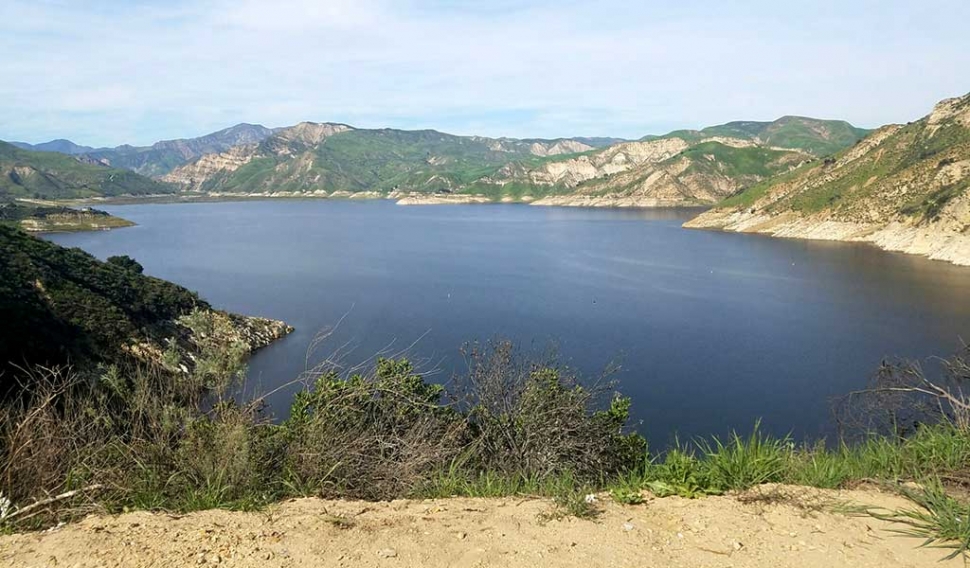|
$130,019 QZAP Grant to Prevent the Spread of Quagga Mussels
 “U.S. Department of the Interior Fish and Wildlife Service Funds to Provide Full-Time Seasonal Staff at Lake Piru to Focus on Outbound Vessel Inspections and Decontamination Efforts.” Photo of Lake Piru taken March 2017. By Anonymous — Wednesday, March 29th, 2017
U.S. Department of the Interior Fish and Wildlife Service Funds to Provide Full-Time Seasonal Staff at Lake Piru to Focus on Outbound Vessel Inspections and Decontamination Efforts
United Water Conservation District (UWCD), the special district tasked with managing, protecting, conserving and enhancing the water resources of the Santa Clara River Valley and Oxnard Plain, has been awarded a grant in the amount of $130,019 from the United States Department of the Interior Fish and Wildlife Service for additional vessel inspection and decontamination staff at its Lake Piru Recreation area in an effort to prevent the spread of the invasive Quagga Mussels, first detected at Lake Piru in December 2013. UWCD owns and oversees the Santa Felicia Dam and Lake Piru reservoir. During winter months, the reservoir captures storm water and in the spring, collects runoff from the nearby Los Padres National Forest in northeastern Ventura County, and the Angeles National Forest in northwestern Los Angeles County. Then in the fall, UWCD releases the water into lower Piru Creek to recharge downstream groundwater aquifers in the Santa Clara River Watershed. The Santa Clara River, nearly 100 miles in length, is the largest non-channelized river in southern California, and is home to several endangered and threatened species. “UWCD’s Lake Piru recreation area is used by boaters from several surrounding counties within coastal California, boaters who typically visit many other lakes in southern and central California, including several that feed natural streams and others that are part of the State Water Project, such as Castaic and Pyramid Lakes,” explained General Manager Mauricio E. Guardado, Jr.. “With the recent announcement that quagga mussels were found at Pyramid and Castaic, the challenges in battling the spread of the highly invasive quagga mussels have grown both in terms of expense and effectiveness. These challenges are compounded further by government regulations which require United to maintain continuous water releases to protect endangered species as well as provide boating, fishing, swimming, camping, and hiking activities in the Lake Piru recreation area. The QZAP grant will allow us to hire additional staff to focus on vessel inspections and provide decontamination when necessary.” UWCD has been working with the California Department of Fish and Wildlife on implementing its Lake Piru Quagga Mussel Monitoring and Control Plan. Due to the complex regulatory requirements associated with the lake, the District is also working with a Quagga Mussel Technical Advisory Committee (TAC) to assist with the development of the monitoring and control options. The primary goals of the plan are to: 1) contain and minimize the spread of quagga mussels to other water bodies; 2) control the quagga population within Lake Piru to minimize, to the extent feasible, environmental and operational effects; 3) collect monitoring data to further characterize and better understand the extent and effects of the infestation within Lake Piru and downstream areas; and 4) use the information obtained from the monitoring and control efforts to adaptively manage the quagga infestation. UWCD’s Lake Piru Quagga Mussel Monitoring and Control Plan project focuses on minimizing the spread of quagga mussels to other water bodies (Goal #1) via private boats and other equipment. Due to the small size of UWCD (some 50 total staff with an approximate $24 million per year overall operating budget), boat inspections and boater education is an area that needs to be strengthened in order to achieve the Containment Project’s goals. The QZAP grant funding awarded by the U.S. Department of the Interior Fish and Wildlife Services will provide for several full-time seasonal staff members who will focus their efforts on outbound vessel inspections and decontamination activities while also assisting in overall public education efforts. About U.S. Fish and Wildlife Service’s QZAP Grant About United Water Conservation District (UWCD) Committed to managing the area’s water supplies through groundwater replenishment and through the construction and operation of efficient water supply and delivery systems, today the District serves as the conservator of groundwater resources that are utilized by the cities of Oxnard, Port Hueneme, Ventura, Santa Paula, and Fillmore, as well as several mutual water districts and numerous farms and individual pumpers. It also provides surface water for agricultural irrigation and provides treated drinking water to the cities of Oxnard and Port Hueneme. For more information, visit http://www.unitedwater.org |
